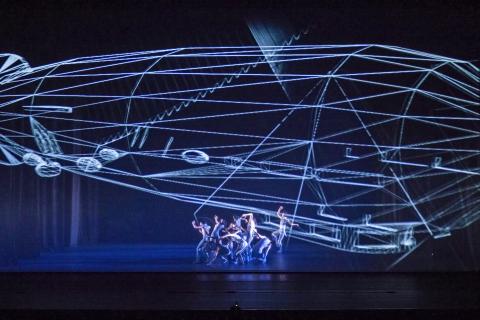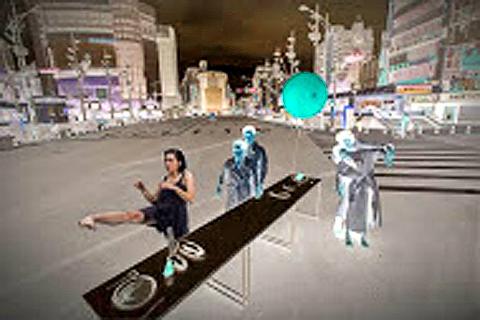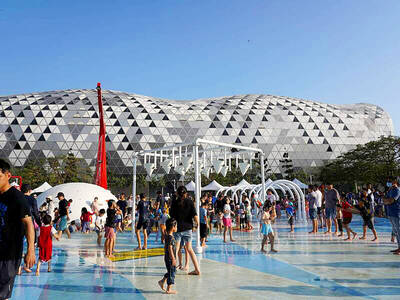The National Theater Concert Hall’s (NTCH) latest 1+1 production pairs two Taiwanese choreographers whose small companies would rarely get the chance to perform on the complex’s main stage on their own — Ho Hsiao-mei (何曉玫) and her Meimage Dance (玫舞擊) plus Lin Wen-chung’s (林文中) WCdance (林文中舞團) — in one program.
Lin said it felt a little funny to share a double bill with Ho, because she had been one of his teachers when he was earning his bachelor’s degree at Taipei National University of the Arts (TNUA, 國立臺北藝術大學), but it was not too weird because they did not actually collaborate, with each troupe presenting its own work.
The two pieces, and their inspirations, could not be more disparate.

Photo courtesy of Wu Chi-tsung
Ho’s piece is entitled Camouflage (假裝), which she said is all about pretense — how humans wear masks when they interact with one another, how we are always pretending in our daily lives. She said she wants to know why, and she drove her six dancers crazy asking them so many questions during the initial rehearsals.
“I kept asking the dancers: When do you pretend? What do you do when you realize you are pretending? How do you know what is real?” she said.
“You have to take care of yourself, listen to yourself, take care of your mask; we are trying to make something true,” she added.

Courtesy of Meimage Dance
Ho said she was also intrigued by the movement and sounds people make when they are alone, when they are not worried that someone might be watching and what they are doing that proves they exist.
“I am fascinated with the pure, concentrated moment,” she said.
Ho said she developed six “paragraphs” or storylines for the 60-minute work, which sees all six dancers onstage for the entire performance.
“I don’t let the dancers go offstage, even when changing clothes, or when we are changing scenes. It is all on stage. The audience will see all the transitions. It is like trying to hide from the subconscious — even if you hide it, it is still there,” she said.
The six stories are a mix of real and imaginary, she said, adding that one was based on a friend who had fallen in love long-distance with a British man, who moved to Taiwan to be with her.
“They started living together, bought furniture, but then realized they couldn’t live together and he went back to Britain,” Ho said. “However, my friend said she was pretending that he was still here; that she would ‘talk to him’ went she went home. I wanted to make a dance for her.”
Ho said the score was crucial to her piece, which focuses on sounds instead of music.
“We put a microphone inside a table to pick up sounds of people touching the table, moving dishes, eating, going about normal life,” she said. ”The work is about the small gestures you make but you don’t know it.”
She turned to Coordt Linke, a German who lives in Taipei, whom she has worked with in the past, to create the soundscape.
While Ho pondered mankind’s attraction to masks, Lin was preoccupied with air, having moved on from liquids, which was the focus of his work last year, Long River (長河).
His piece, Aerodynamics (空氣動力學), was inspired by his past; he was in the model airplane club in high school and was once a national champion.
“I wanted to let the audience ‘see the air,’” Lin said, adding that the dancers are like dust motes — little particles that float through the air — allowing us to see the currents that propel them.
The set created by Wu Chi-tsung (吳季璁) looks amazing, with graphic projections and long strips of filmy material hanging from the rafters.
When the streamers drop, “it is like nature — the humans are small,” Lin said.
“I wanted to make something to make you go ‘wow’ in the first three minutes, then build up again,” he added. “I told the animation designer that I wanted something like a war movie or Star Wars, like the beginning of airplanes.”
To create a feeling of flying, Lin said there are banks of fans, all connected to a computer, on the sides and back of the stage to make the material curve and flow. They also make it seem as if the dancers are being tossed about in the air, much like dust motes.
Aerodynamics is set on 12 dancers, WCdance’s biggest crew to date.
“The energy is at different levels, the dancers slide, they lift. What I like most about the big stage is you can put different layers, like a movie,” Lin said.
The show had its world premiere early last month in Macau. It turned out that by the time NTCH asked Lin last year to create a new work for this month, he had already committed to the Macau Arts Festival, so he suggested the festival and the NTCH co-produce Aerodynamics.

The Taipei Times last week reported that the rising share of seniors in the population is reshaping the nation’s housing markets. According to data from the Ministry of the Interior, about 850,000 residences were occupied by elderly people in the first quarter, including 655,000 that housed only one resident. H&B Realty chief researcher Jessica Hsu (徐佳馨), quoted in the article, said that there is rising demand for elderly-friendly housing, including units with elevators, barrier-free layouts and proximity to healthcare services. Hsu and others cited in the article highlighted the changing family residential dynamics, as children no longer live with parents,

Oct 20 to Oct 26 After a day of fighting, the Japanese Army’s Second Division was resting when a curious delegation of two Scotsmen and 19 Taiwanese approached their camp. It was Oct. 20, 1895, and the troops had reached Taiye Village (太爺庄) in today’s Hunei District (湖內), Kaohsiung, just 10km away from their final target of Tainan. Led by Presbyterian missionaries Thomas Barclay and Duncan Ferguson, the group informed the Japanese that resistance leader Liu Yung-fu (劉永福) had fled to China the previous night, leaving his Black Flag Army fighters behind and the city in chaos. On behalf of the

I was 10 when I read an article in the local paper about the Air Guitar World Championships, which take place every year in my home town of Oulu, Finland. My parents had helped out at the very first contest back in 1996 — my mum gave out fliers, my dad sorted the music. Since then, national championships have been held all across the world, with the winners assembling in Oulu every summer. At the time, I asked my parents if I could compete. At first they were hesitant; the event was in a bar, and there would be a lot

The election of Cheng Li-wun (鄭麗文) as chair of the Chinese Nationalist Party (KMT) marked a triumphant return of pride in the “Chinese” in the party name. Cheng wants Taiwanese to be proud to call themselves Chinese again. The unambiguous winner was a return to the KMT ideology that formed in the early 2000s under then chairman Lien Chan (連戰) and president Ma Ying-jeou (馬英九) put into practice as far as he could, until ultimately thwarted by hundreds of thousands of protestors thronging the streets in what became known as the Sunflower movement in 2014. Cheng is an unambiguous Chinese ethnonationalist,